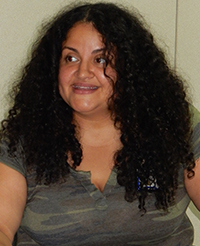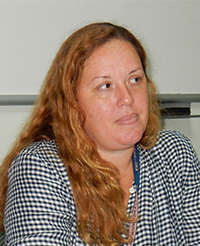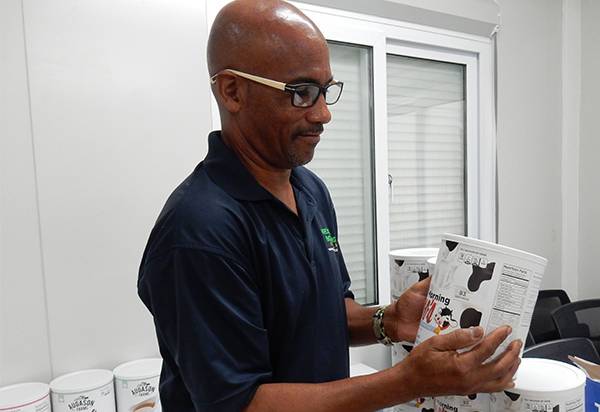You are here
Helping CDC Beyond the Eye of The Storm
On September 7, Category 5 Hurricane Irma struck a glancing blow on Puerto Rico, causing widespread damage and power outages. Then, less than two weeks later, Category 4 Hurricane Maria landed a direct hit on the island, leaving behind catastrophic damage and initiating a humanitarian crisis. Watching this story unfold at that time from my own home was intense—the photos, videos and pleas for help all indicated the immediate need to move quickly with relief.
CDC sprang to action through its Emergency Operations Center, working to address public health needs that arose. The CDC Foundation followed suit by raising support for the general hurricane response as well as seeking support for CDC’s Puerto Rico-based staff in San Juan through the Foundation’s CDC Health Worker Relief Fund.
 “What was harder than anything was the humanitarian crisis,” said Gladys D. Gonzalez Aviles, branch quality manager, CDC Dengue Branch. “The humanitarian crisis we experienced will live with us forever.”
“What was harder than anything was the humanitarian crisis,” said Gladys D. Gonzalez Aviles, branch quality manager, CDC Dengue Branch. “The humanitarian crisis we experienced will live with us forever.”
Generous support for the CDC Foundation’s fund has been provided by current CDC employees, retirees, current and former Epidemic Intelligence Service officers, Watsonian Society members and others. Initially, the CDC Foundation purchased and sent supplies, such as food, water, batteries and generators, to assist CDC’s Puerto Rico-based staff so that they could help stabilize their own situations and then aid in the broader response. Beyond this initial support, CDC Puerto Rico staff are eligible to apply for additional assistance from the fund to meet their individual and family needs.
As part of my job, I traveled to Puerto Rico on November 15. I was anxious and unsure about what would meet me on the other side of the airplane doors, hesitant about what I would see, hear and feel. As the doors opened, I took a deep breath while grabbing my belongings and exiting the plane. Inside the airport, there were no tourists in sight, and the airport was much quieter than I had experienced in many previous trips to the island.
It became obvious that the people I did see were there on a mission to provide relief. Everyone walked with a purpose, appearing focused on helping the people of Puerto Rico—our fellow Americans. During my seven-day stay, I visited three cities: San Juan, Ponce and Humacao. Each place I visited exhibited varying levels of devastation and recovery.
San Juan, being a metropolitan area, appeared better than I anticipated, yet there were still many signs of damage. Small businesses were closed with no reopen date in sight. Signs were destroyed and only a few traffic lights appeared to be working. Yet, hotels proceeded with business, housing many responders and relief staff as they try to recoup some of the lost tourist revenue.
 “I live in a community in the metro area and I didn’t lose my home but there is still a sense trauma,” said Janice Perez-Padilla, CDC nurse epidemiologist. “There is a sense of loss in all of us. We all lost the home that we used to know as an island. There is no one on this island that is untouched in some way.”
“I live in a community in the metro area and I didn’t lose my home but there is still a sense trauma,” said Janice Perez-Padilla, CDC nurse epidemiologist. “There is a sense of loss in all of us. We all lost the home that we used to know as an island. There is no one on this island that is untouched in some way.”
On the drive to Ponce on the southern part of the island, I started to see how life outside the metropolitan area was functioning. Many highway signs were missing, trees and debris still needed to be removed and many homes were damaged. I arrived for a meeting at the hospital there and the lights immediately flickered. While I paused, everyone else continued with business as usual. Obviously, electricity outages have become a normal occurrence.
The situation in Humacao, on the east side of the island, was shocking. Personally, I have never seen such devastation, and it seemed as though the hurricane had only happened a few weeks ago, as opposed to two months before my visit. People were displaced, businesses were ruined, electrical lines were damaged, and I had a palpable feeling of insecurity.
Yet even in Humacao, Puerto Rican flags flew proudly. People there were proud of their home and committed to join together and work as a community in the face of despair.
In the latter part of my trip, I connected with some of CDC's staff based in Puerto Rico. It was moving to hear stories about their individual situations following the storm. I felt a rollercoaster of emotions in each conversation, and I could sense their weariness. Nonetheless, each staff member was quick to share their deep appreciation for the supplies provided through the CDC Health Worker Relief Fund.
“Muchas, muchas gracias! Everything you gave me, I needed,” said an appreciative Jose L. Acosta Rivera, maintenance contractor. “Flashlights, batteries, a generator, food, water—I needed it.”
While many needs have been met, there is still an opportunity to provide much-needed support to help CDC staff continue to rebuild their lives. Learn how you can make a difference.
When asked about the future, a common theme that emerged from each person I spoke with is that Puerto Rico will come back stronger. There is no denying there is significant work still to be done, but helping to build the future of Puerto Rico is motivating and inspiring people there.

